BMP6002 Strategic Management: Analyzing Prescriptive and Emergent
VerifiedAdded on 2023/06/15
|11
|2907
|173
Essay
AI Summary
This essay delves into strategic management, comparing prescriptive and emergent approaches, and exploring their roles in achieving organizational goals with sustainable competitive advantage. It critically evaluates the application of SWOT analysis, highlighting its limitations as a 'blunt tool' in strategy management and advocating for complementary frameworks. The essay also contrasts the PESTLE analysis and Porter’s Five Forces model, examining how managers can use these tools to assess the environmental impact on an organization's competitive position. Through detailed analysis and examples, the essay provides a comprehensive understanding of strategic management principles and their practical application in diverse organizational contexts. Desklib provides access to this and other solved assignments.
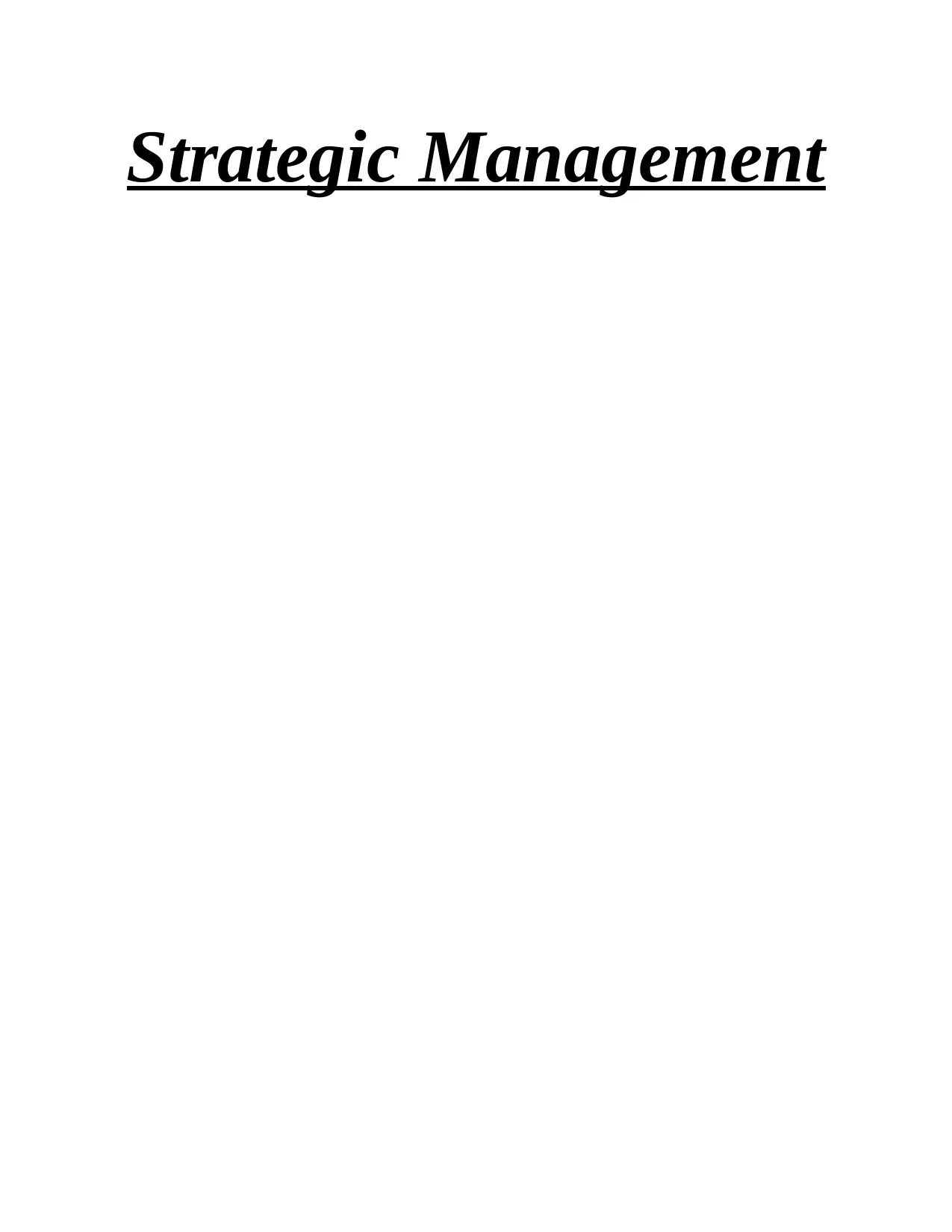
Strategic Management
Paraphrase This Document
Need a fresh take? Get an instant paraphrase of this document with our AI Paraphraser
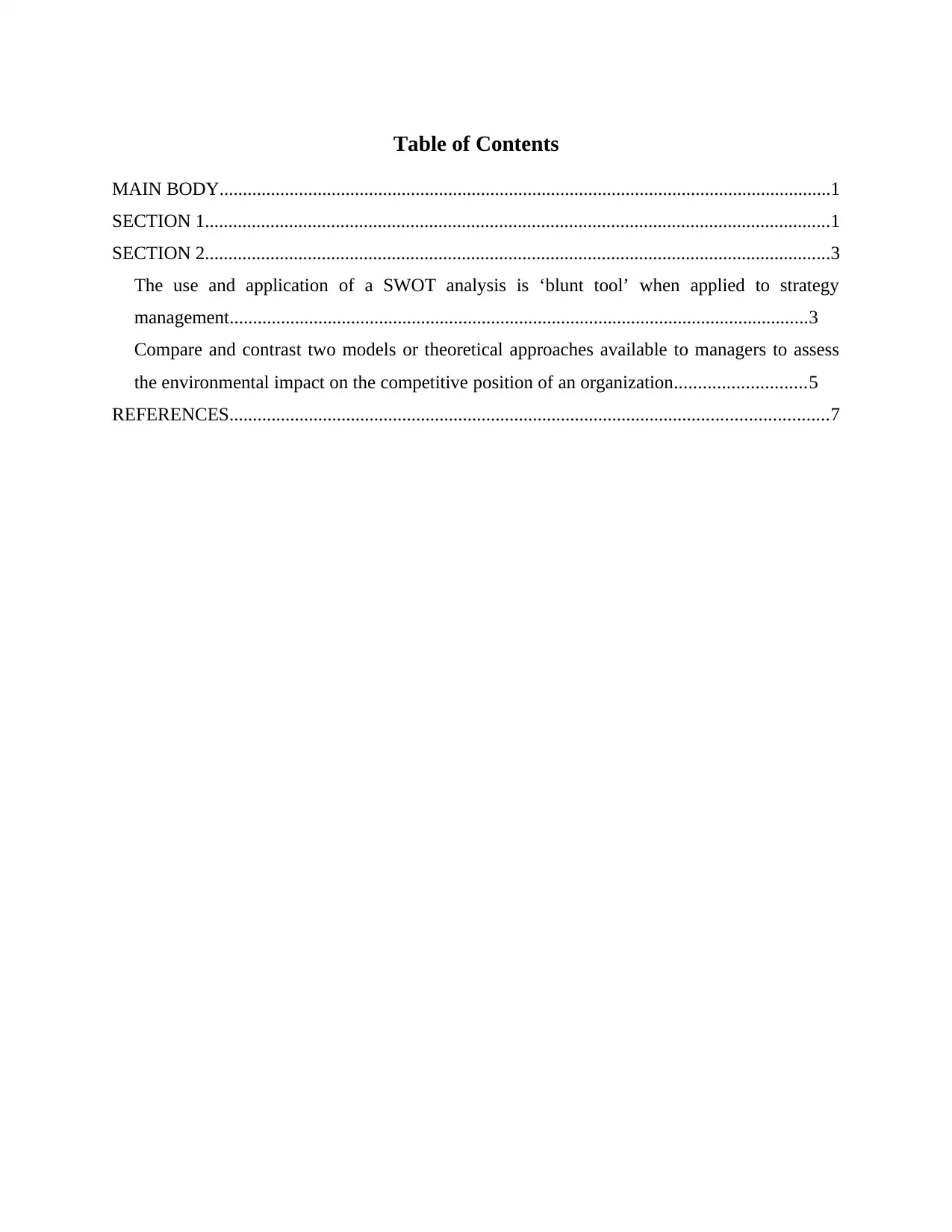
Table of Contents
MAIN BODY...................................................................................................................................1
SECTION 1......................................................................................................................................1
SECTION 2......................................................................................................................................3
The use and application of a SWOT analysis is ‘blunt tool’ when applied to strategy
management............................................................................................................................3
Compare and contrast two models or theoretical approaches available to managers to assess
the environmental impact on the competitive position of an organization............................5
REFERENCES................................................................................................................................7
MAIN BODY...................................................................................................................................1
SECTION 1......................................................................................................................................1
SECTION 2......................................................................................................................................3
The use and application of a SWOT analysis is ‘blunt tool’ when applied to strategy
management............................................................................................................................3
Compare and contrast two models or theoretical approaches available to managers to assess
the environmental impact on the competitive position of an organization............................5
REFERENCES................................................................................................................................7
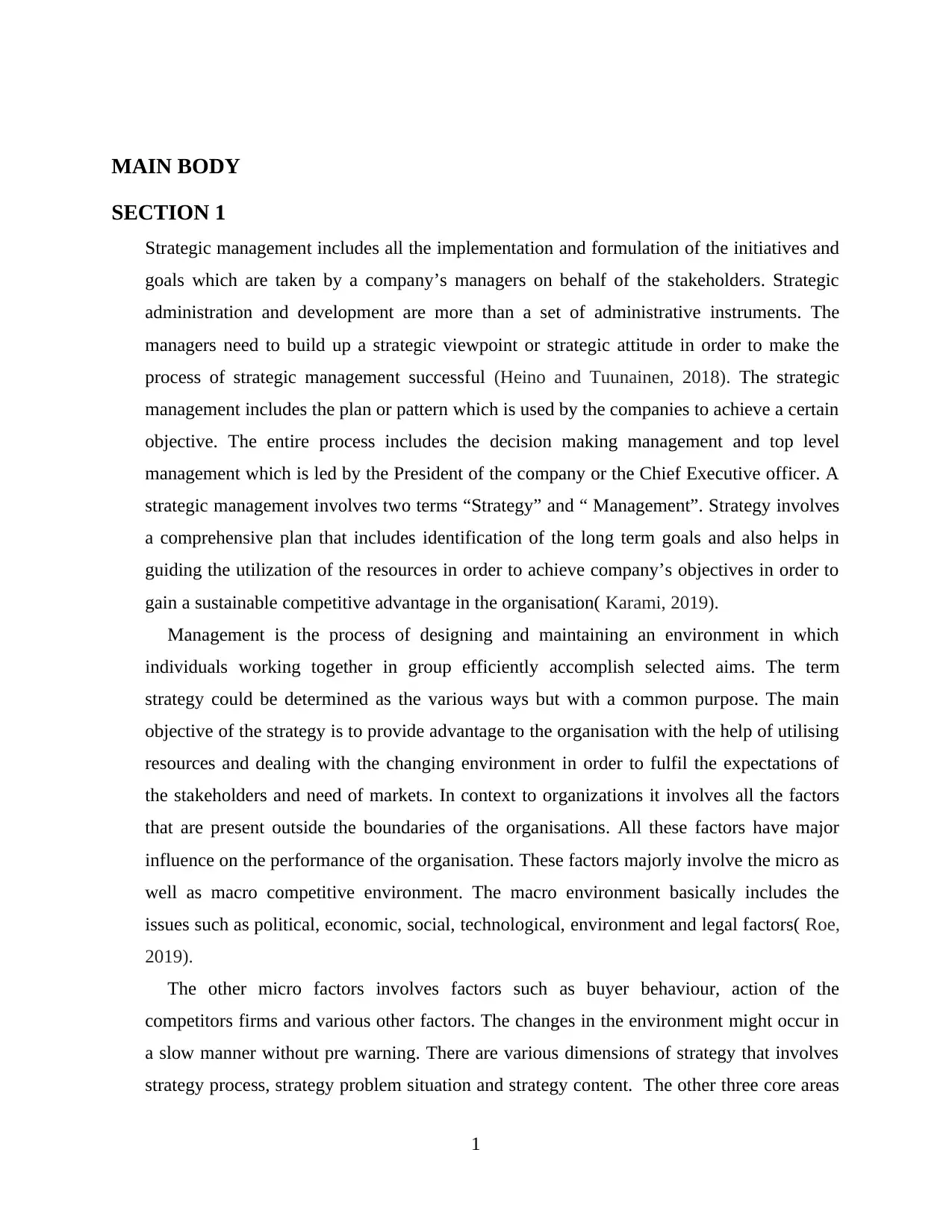
MAIN BODY
SECTION 1
Strategic management includes all the implementation and formulation of the initiatives and
goals which are taken by a company’s managers on behalf of the stakeholders. Strategic
administration and development are more than a set of administrative instruments. The
managers need to build up a strategic viewpoint or strategic attitude in order to make the
process of strategic management successful (Heino and Tuunainen, 2018). The strategic
management includes the plan or pattern which is used by the companies to achieve a certain
objective. The entire process includes the decision making management and top level
management which is led by the President of the company or the Chief Executive officer. A
strategic management involves two terms “Strategy” and “ Management”. Strategy involves
a comprehensive plan that includes identification of the long term goals and also helps in
guiding the utilization of the resources in order to achieve company’s objectives in order to
gain a sustainable competitive advantage in the organisation( Karami, 2019).
Management is the process of designing and maintaining an environment in which
individuals working together in group efficiently accomplish selected aims. The term
strategy could be determined as the various ways but with a common purpose. The main
objective of the strategy is to provide advantage to the organisation with the help of utilising
resources and dealing with the changing environment in order to fulfil the expectations of
the stakeholders and need of markets. In context to organizations it involves all the factors
that are present outside the boundaries of the organisations. All these factors have major
influence on the performance of the organisation. These factors majorly involve the micro as
well as macro competitive environment. The macro environment basically includes the
issues such as political, economic, social, technological, environment and legal factors( Roe,
2019).
The other micro factors involves factors such as buyer behaviour, action of the
competitors firms and various other factors. The changes in the environment might occur in
a slow manner without pre warning. There are various dimensions of strategy that involves
strategy process, strategy problem situation and strategy content. The other three core areas
1
SECTION 1
Strategic management includes all the implementation and formulation of the initiatives and
goals which are taken by a company’s managers on behalf of the stakeholders. Strategic
administration and development are more than a set of administrative instruments. The
managers need to build up a strategic viewpoint or strategic attitude in order to make the
process of strategic management successful (Heino and Tuunainen, 2018). The strategic
management includes the plan or pattern which is used by the companies to achieve a certain
objective. The entire process includes the decision making management and top level
management which is led by the President of the company or the Chief Executive officer. A
strategic management involves two terms “Strategy” and “ Management”. Strategy involves
a comprehensive plan that includes identification of the long term goals and also helps in
guiding the utilization of the resources in order to achieve company’s objectives in order to
gain a sustainable competitive advantage in the organisation( Karami, 2019).
Management is the process of designing and maintaining an environment in which
individuals working together in group efficiently accomplish selected aims. The term
strategy could be determined as the various ways but with a common purpose. The main
objective of the strategy is to provide advantage to the organisation with the help of utilising
resources and dealing with the changing environment in order to fulfil the expectations of
the stakeholders and need of markets. In context to organizations it involves all the factors
that are present outside the boundaries of the organisations. All these factors have major
influence on the performance of the organisation. These factors majorly involve the micro as
well as macro competitive environment. The macro environment basically includes the
issues such as political, economic, social, technological, environment and legal factors( Roe,
2019).
The other micro factors involves factors such as buyer behaviour, action of the
competitors firms and various other factors. The changes in the environment might occur in
a slow manner without pre warning. There are various dimensions of strategy that involves
strategy process, strategy problem situation and strategy content. The other three core areas
1
⊘ This is a preview!⊘
Do you want full access?
Subscribe today to unlock all pages.

Trusted by 1+ million students worldwide
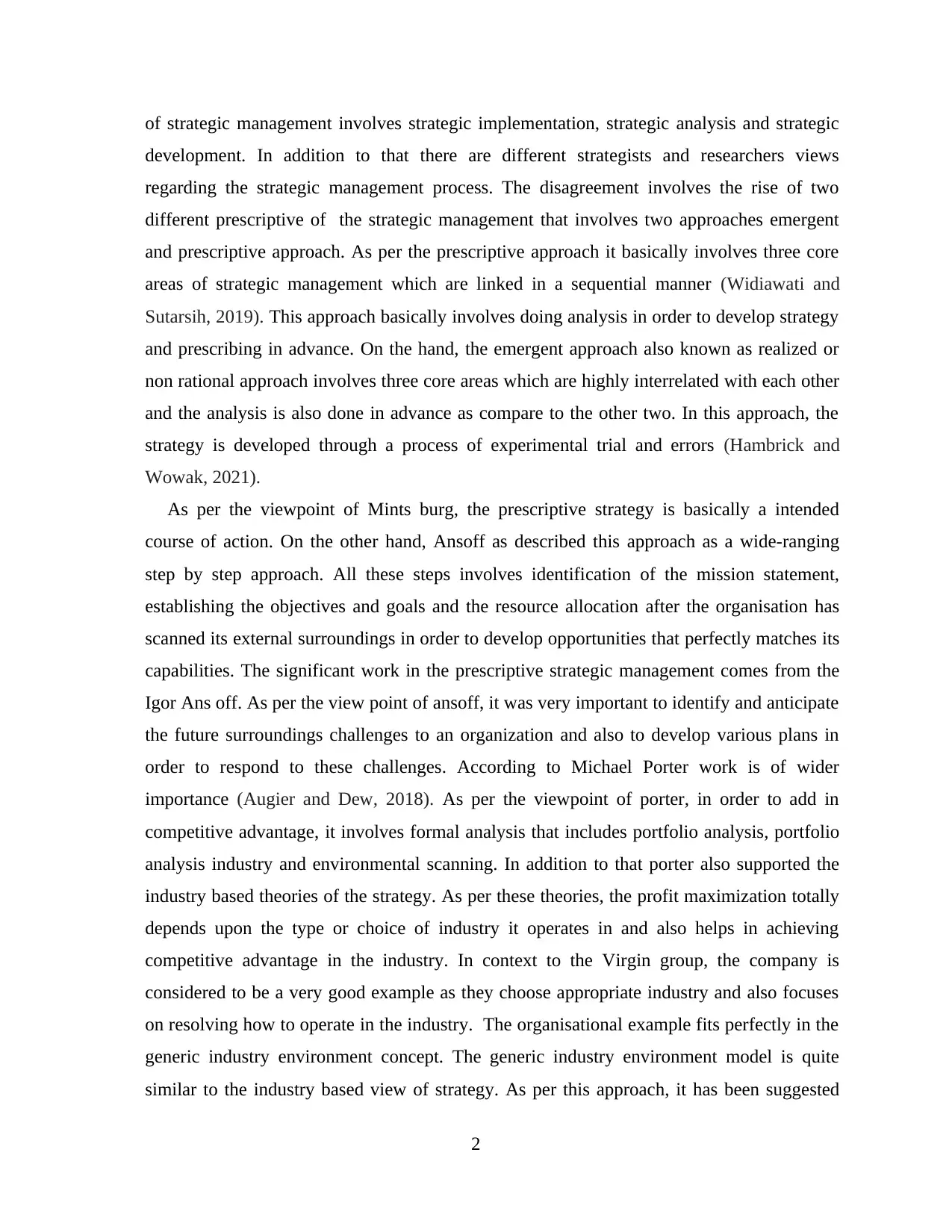
of strategic management involves strategic implementation, strategic analysis and strategic
development. In addition to that there are different strategists and researchers views
regarding the strategic management process. The disagreement involves the rise of two
different prescriptive of the strategic management that involves two approaches emergent
and prescriptive approach. As per the prescriptive approach it basically involves three core
areas of strategic management which are linked in a sequential manner (Widiawati and
Sutarsih, 2019). This approach basically involves doing analysis in order to develop strategy
and prescribing in advance. On the hand, the emergent approach also known as realized or
non rational approach involves three core areas which are highly interrelated with each other
and the analysis is also done in advance as compare to the other two. In this approach, the
strategy is developed through a process of experimental trial and errors (Hambrick and
Wowak, 2021).
As per the viewpoint of Mints burg, the prescriptive strategy is basically a intended
course of action. On the other hand, Ansoff as described this approach as a wide-ranging
step by step approach. All these steps involves identification of the mission statement,
establishing the objectives and goals and the resource allocation after the organisation has
scanned its external surroundings in order to develop opportunities that perfectly matches its
capabilities. The significant work in the prescriptive strategic management comes from the
Igor Ans off. As per the view point of ansoff, it was very important to identify and anticipate
the future surroundings challenges to an organization and also to develop various plans in
order to respond to these challenges. According to Michael Porter work is of wider
importance (Augier and Dew, 2018). As per the viewpoint of porter, in order to add in
competitive advantage, it involves formal analysis that includes portfolio analysis, portfolio
analysis industry and environmental scanning. In addition to that porter also supported the
industry based theories of the strategy. As per these theories, the profit maximization totally
depends upon the type or choice of industry it operates in and also helps in achieving
competitive advantage in the industry. In context to the Virgin group, the company is
considered to be a very good example as they choose appropriate industry and also focuses
on resolving how to operate in the industry. The organisational example fits perfectly in the
generic industry environment concept. The generic industry environment model is quite
similar to the industry based view of strategy. As per this approach, it has been suggested
2
development. In addition to that there are different strategists and researchers views
regarding the strategic management process. The disagreement involves the rise of two
different prescriptive of the strategic management that involves two approaches emergent
and prescriptive approach. As per the prescriptive approach it basically involves three core
areas of strategic management which are linked in a sequential manner (Widiawati and
Sutarsih, 2019). This approach basically involves doing analysis in order to develop strategy
and prescribing in advance. On the hand, the emergent approach also known as realized or
non rational approach involves three core areas which are highly interrelated with each other
and the analysis is also done in advance as compare to the other two. In this approach, the
strategy is developed through a process of experimental trial and errors (Hambrick and
Wowak, 2021).
As per the viewpoint of Mints burg, the prescriptive strategy is basically a intended
course of action. On the other hand, Ansoff as described this approach as a wide-ranging
step by step approach. All these steps involves identification of the mission statement,
establishing the objectives and goals and the resource allocation after the organisation has
scanned its external surroundings in order to develop opportunities that perfectly matches its
capabilities. The significant work in the prescriptive strategic management comes from the
Igor Ans off. As per the view point of ansoff, it was very important to identify and anticipate
the future surroundings challenges to an organization and also to develop various plans in
order to respond to these challenges. According to Michael Porter work is of wider
importance (Augier and Dew, 2018). As per the viewpoint of porter, in order to add in
competitive advantage, it involves formal analysis that includes portfolio analysis, portfolio
analysis industry and environmental scanning. In addition to that porter also supported the
industry based theories of the strategy. As per these theories, the profit maximization totally
depends upon the type or choice of industry it operates in and also helps in achieving
competitive advantage in the industry. In context to the Virgin group, the company is
considered to be a very good example as they choose appropriate industry and also focuses
on resolving how to operate in the industry. The organisational example fits perfectly in the
generic industry environment concept. The generic industry environment model is quite
similar to the industry based view of strategy. As per this approach, it has been suggested
2
Paraphrase This Document
Need a fresh take? Get an instant paraphrase of this document with our AI Paraphraser
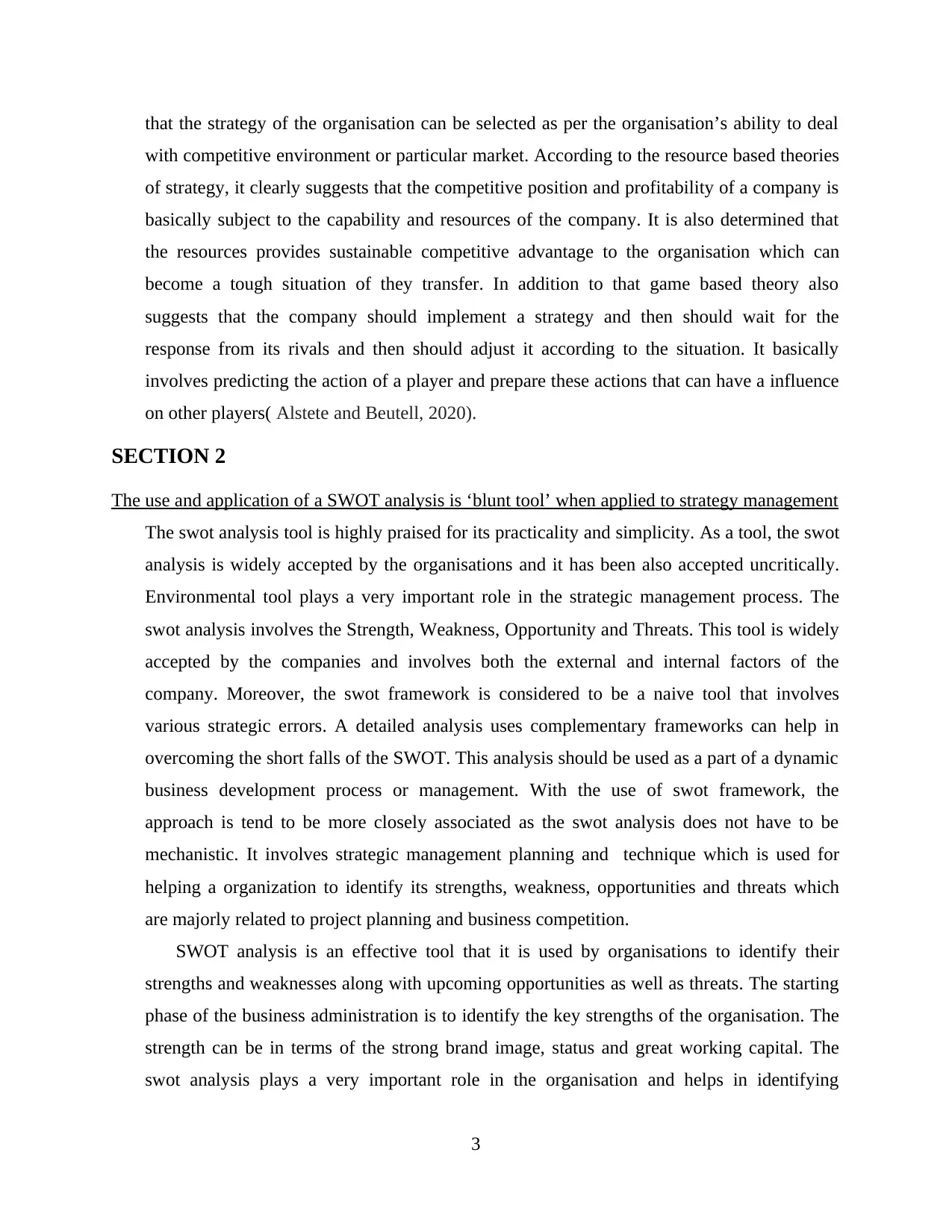
that the strategy of the organisation can be selected as per the organisation’s ability to deal
with competitive environment or particular market. According to the resource based theories
of strategy, it clearly suggests that the competitive position and profitability of a company is
basically subject to the capability and resources of the company. It is also determined that
the resources provides sustainable competitive advantage to the organisation which can
become a tough situation of they transfer. In addition to that game based theory also
suggests that the company should implement a strategy and then should wait for the
response from its rivals and then should adjust it according to the situation. It basically
involves predicting the action of a player and prepare these actions that can have a influence
on other players( Alstete and Beutell, 2020).
SECTION 2
The use and application of a SWOT analysis is ‘blunt tool’ when applied to strategy management
The swot analysis tool is highly praised for its practicality and simplicity. As a tool, the swot
analysis is widely accepted by the organisations and it has been also accepted uncritically.
Environmental tool plays a very important role in the strategic management process. The
swot analysis involves the Strength, Weakness, Opportunity and Threats. This tool is widely
accepted by the companies and involves both the external and internal factors of the
company. Moreover, the swot framework is considered to be a naive tool that involves
various strategic errors. A detailed analysis uses complementary frameworks can help in
overcoming the short falls of the SWOT. This analysis should be used as a part of a dynamic
business development process or management. With the use of swot framework, the
approach is tend to be more closely associated as the swot analysis does not have to be
mechanistic. It involves strategic management planning and technique which is used for
helping a organization to identify its strengths, weakness, opportunities and threats which
are majorly related to project planning and business competition.
SWOT analysis is an effective tool that it is used by organisations to identify their
strengths and weaknesses along with upcoming opportunities as well as threats. The starting
phase of the business administration is to identify the key strengths of the organisation. The
strength can be in terms of the strong brand image, status and great working capital. The
swot analysis plays a very important role in the organisation and helps in identifying
3
with competitive environment or particular market. According to the resource based theories
of strategy, it clearly suggests that the competitive position and profitability of a company is
basically subject to the capability and resources of the company. It is also determined that
the resources provides sustainable competitive advantage to the organisation which can
become a tough situation of they transfer. In addition to that game based theory also
suggests that the company should implement a strategy and then should wait for the
response from its rivals and then should adjust it according to the situation. It basically
involves predicting the action of a player and prepare these actions that can have a influence
on other players( Alstete and Beutell, 2020).
SECTION 2
The use and application of a SWOT analysis is ‘blunt tool’ when applied to strategy management
The swot analysis tool is highly praised for its practicality and simplicity. As a tool, the swot
analysis is widely accepted by the organisations and it has been also accepted uncritically.
Environmental tool plays a very important role in the strategic management process. The
swot analysis involves the Strength, Weakness, Opportunity and Threats. This tool is widely
accepted by the companies and involves both the external and internal factors of the
company. Moreover, the swot framework is considered to be a naive tool that involves
various strategic errors. A detailed analysis uses complementary frameworks can help in
overcoming the short falls of the SWOT. This analysis should be used as a part of a dynamic
business development process or management. With the use of swot framework, the
approach is tend to be more closely associated as the swot analysis does not have to be
mechanistic. It involves strategic management planning and technique which is used for
helping a organization to identify its strengths, weakness, opportunities and threats which
are majorly related to project planning and business competition.
SWOT analysis is an effective tool that it is used by organisations to identify their
strengths and weaknesses along with upcoming opportunities as well as threats. The starting
phase of the business administration is to identify the key strengths of the organisation. The
strength can be in terms of the strong brand image, status and great working capital. The
swot analysis plays a very important role in the organisation and helps in identifying
3
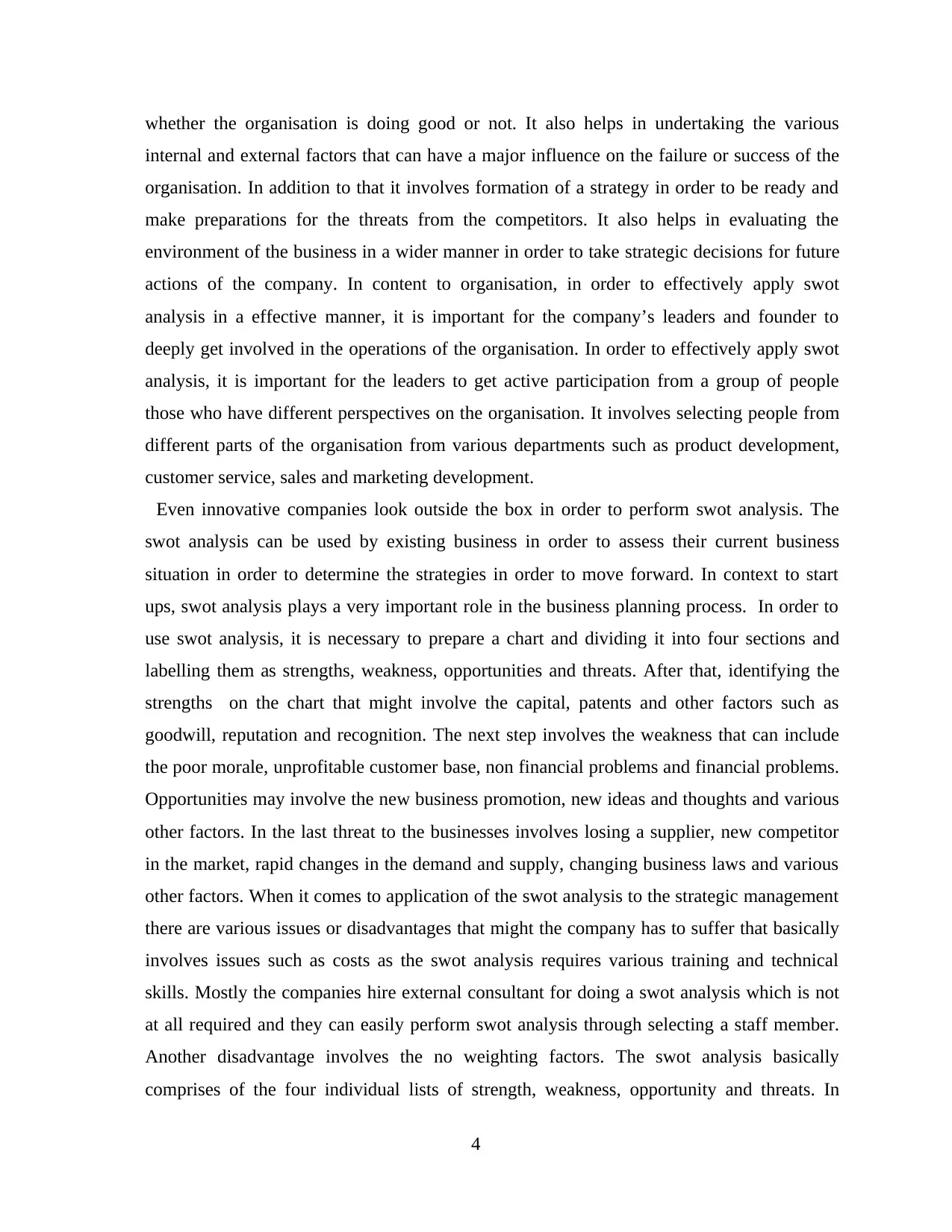
whether the organisation is doing good or not. It also helps in undertaking the various
internal and external factors that can have a major influence on the failure or success of the
organisation. In addition to that it involves formation of a strategy in order to be ready and
make preparations for the threats from the competitors. It also helps in evaluating the
environment of the business in a wider manner in order to take strategic decisions for future
actions of the company. In content to organisation, in order to effectively apply swot
analysis in a effective manner, it is important for the company’s leaders and founder to
deeply get involved in the operations of the organisation. In order to effectively apply swot
analysis, it is important for the leaders to get active participation from a group of people
those who have different perspectives on the organisation. It involves selecting people from
different parts of the organisation from various departments such as product development,
customer service, sales and marketing development.
Even innovative companies look outside the box in order to perform swot analysis. The
swot analysis can be used by existing business in order to assess their current business
situation in order to determine the strategies in order to move forward. In context to start
ups, swot analysis plays a very important role in the business planning process. In order to
use swot analysis, it is necessary to prepare a chart and dividing it into four sections and
labelling them as strengths, weakness, opportunities and threats. After that, identifying the
strengths on the chart that might involve the capital, patents and other factors such as
goodwill, reputation and recognition. The next step involves the weakness that can include
the poor morale, unprofitable customer base, non financial problems and financial problems.
Opportunities may involve the new business promotion, new ideas and thoughts and various
other factors. In the last threat to the businesses involves losing a supplier, new competitor
in the market, rapid changes in the demand and supply, changing business laws and various
other factors. When it comes to application of the swot analysis to the strategic management
there are various issues or disadvantages that might the company has to suffer that basically
involves issues such as costs as the swot analysis requires various training and technical
skills. Mostly the companies hire external consultant for doing a swot analysis which is not
at all required and they can easily perform swot analysis through selecting a staff member.
Another disadvantage involves the no weighting factors. The swot analysis basically
comprises of the four individual lists of strength, weakness, opportunity and threats. In
4
internal and external factors that can have a major influence on the failure or success of the
organisation. In addition to that it involves formation of a strategy in order to be ready and
make preparations for the threats from the competitors. It also helps in evaluating the
environment of the business in a wider manner in order to take strategic decisions for future
actions of the company. In content to organisation, in order to effectively apply swot
analysis in a effective manner, it is important for the company’s leaders and founder to
deeply get involved in the operations of the organisation. In order to effectively apply swot
analysis, it is important for the leaders to get active participation from a group of people
those who have different perspectives on the organisation. It involves selecting people from
different parts of the organisation from various departments such as product development,
customer service, sales and marketing development.
Even innovative companies look outside the box in order to perform swot analysis. The
swot analysis can be used by existing business in order to assess their current business
situation in order to determine the strategies in order to move forward. In context to start
ups, swot analysis plays a very important role in the business planning process. In order to
use swot analysis, it is necessary to prepare a chart and dividing it into four sections and
labelling them as strengths, weakness, opportunities and threats. After that, identifying the
strengths on the chart that might involve the capital, patents and other factors such as
goodwill, reputation and recognition. The next step involves the weakness that can include
the poor morale, unprofitable customer base, non financial problems and financial problems.
Opportunities may involve the new business promotion, new ideas and thoughts and various
other factors. In the last threat to the businesses involves losing a supplier, new competitor
in the market, rapid changes in the demand and supply, changing business laws and various
other factors. When it comes to application of the swot analysis to the strategic management
there are various issues or disadvantages that might the company has to suffer that basically
involves issues such as costs as the swot analysis requires various training and technical
skills. Mostly the companies hire external consultant for doing a swot analysis which is not
at all required and they can easily perform swot analysis through selecting a staff member.
Another disadvantage involves the no weighting factors. The swot analysis basically
comprises of the four individual lists of strength, weakness, opportunity and threats. In
4
⊘ This is a preview!⊘
Do you want full access?
Subscribe today to unlock all pages.

Trusted by 1+ million students worldwide
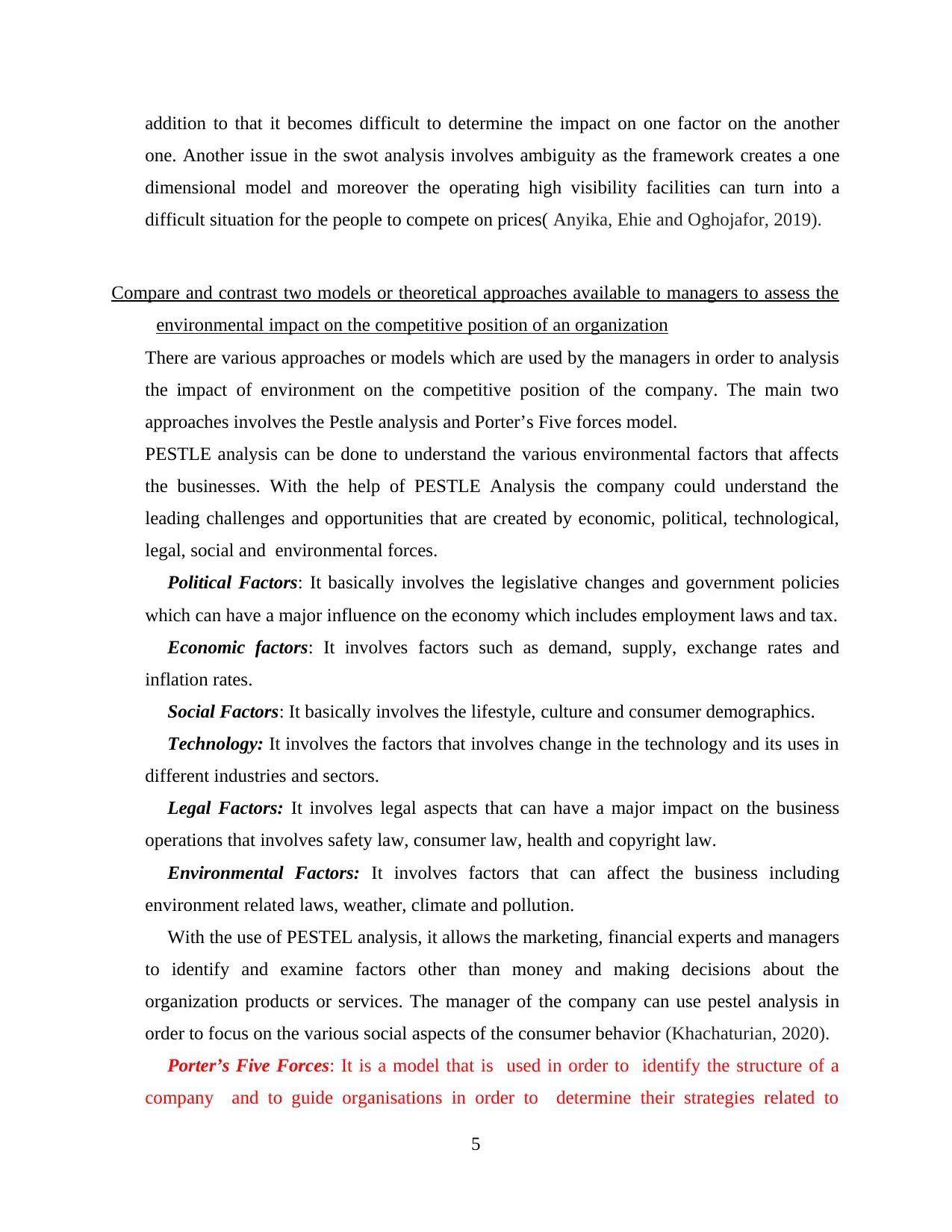
addition to that it becomes difficult to determine the impact on one factor on the another
one. Another issue in the swot analysis involves ambiguity as the framework creates a one
dimensional model and moreover the operating high visibility facilities can turn into a
difficult situation for the people to compete on prices( Anyika, Ehie and Oghojafor, 2019).
Compare and contrast two models or theoretical approaches available to managers to assess the
environmental impact on the competitive position of an organization
There are various approaches or models which are used by the managers in order to analysis
the impact of environment on the competitive position of the company. The main two
approaches involves the Pestle analysis and Porter’s Five forces model.
PESTLE analysis can be done to understand the various environmental factors that affects
the businesses. With the help of PESTLE Analysis the company could understand the
leading challenges and opportunities that are created by economic, political, technological,
legal, social and environmental forces.
Political Factors: It basically involves the legislative changes and government policies
which can have a major influence on the economy which includes employment laws and tax.
Economic factors: It involves factors such as demand, supply, exchange rates and
inflation rates.
Social Factors: It basically involves the lifestyle, culture and consumer demographics.
Technology: It involves the factors that involves change in the technology and its uses in
different industries and sectors.
Legal Factors: It involves legal aspects that can have a major impact on the business
operations that involves safety law, consumer law, health and copyright law.
Environmental Factors: It involves factors that can affect the business including
environment related laws, weather, climate and pollution.
With the use of PESTEL analysis, it allows the marketing, financial experts and managers
to identify and examine factors other than money and making decisions about the
organization products or services. The manager of the company can use pestel analysis in
order to focus on the various social aspects of the consumer behavior (Khachaturian, 2020).
Porter’s Five Forces: It is a model that is used in order to identify the structure of a
company and to guide organisations in order to determine their strategies related to
5
one. Another issue in the swot analysis involves ambiguity as the framework creates a one
dimensional model and moreover the operating high visibility facilities can turn into a
difficult situation for the people to compete on prices( Anyika, Ehie and Oghojafor, 2019).
Compare and contrast two models or theoretical approaches available to managers to assess the
environmental impact on the competitive position of an organization
There are various approaches or models which are used by the managers in order to analysis
the impact of environment on the competitive position of the company. The main two
approaches involves the Pestle analysis and Porter’s Five forces model.
PESTLE analysis can be done to understand the various environmental factors that affects
the businesses. With the help of PESTLE Analysis the company could understand the
leading challenges and opportunities that are created by economic, political, technological,
legal, social and environmental forces.
Political Factors: It basically involves the legislative changes and government policies
which can have a major influence on the economy which includes employment laws and tax.
Economic factors: It involves factors such as demand, supply, exchange rates and
inflation rates.
Social Factors: It basically involves the lifestyle, culture and consumer demographics.
Technology: It involves the factors that involves change in the technology and its uses in
different industries and sectors.
Legal Factors: It involves legal aspects that can have a major impact on the business
operations that involves safety law, consumer law, health and copyright law.
Environmental Factors: It involves factors that can affect the business including
environment related laws, weather, climate and pollution.
With the use of PESTEL analysis, it allows the marketing, financial experts and managers
to identify and examine factors other than money and making decisions about the
organization products or services. The manager of the company can use pestel analysis in
order to focus on the various social aspects of the consumer behavior (Khachaturian, 2020).
Porter’s Five Forces: It is a model that is used in order to identify the structure of a
company and to guide organisations in order to determine their strategies related to
5
Paraphrase This Document
Need a fresh take? Get an instant paraphrase of this document with our AI Paraphraser
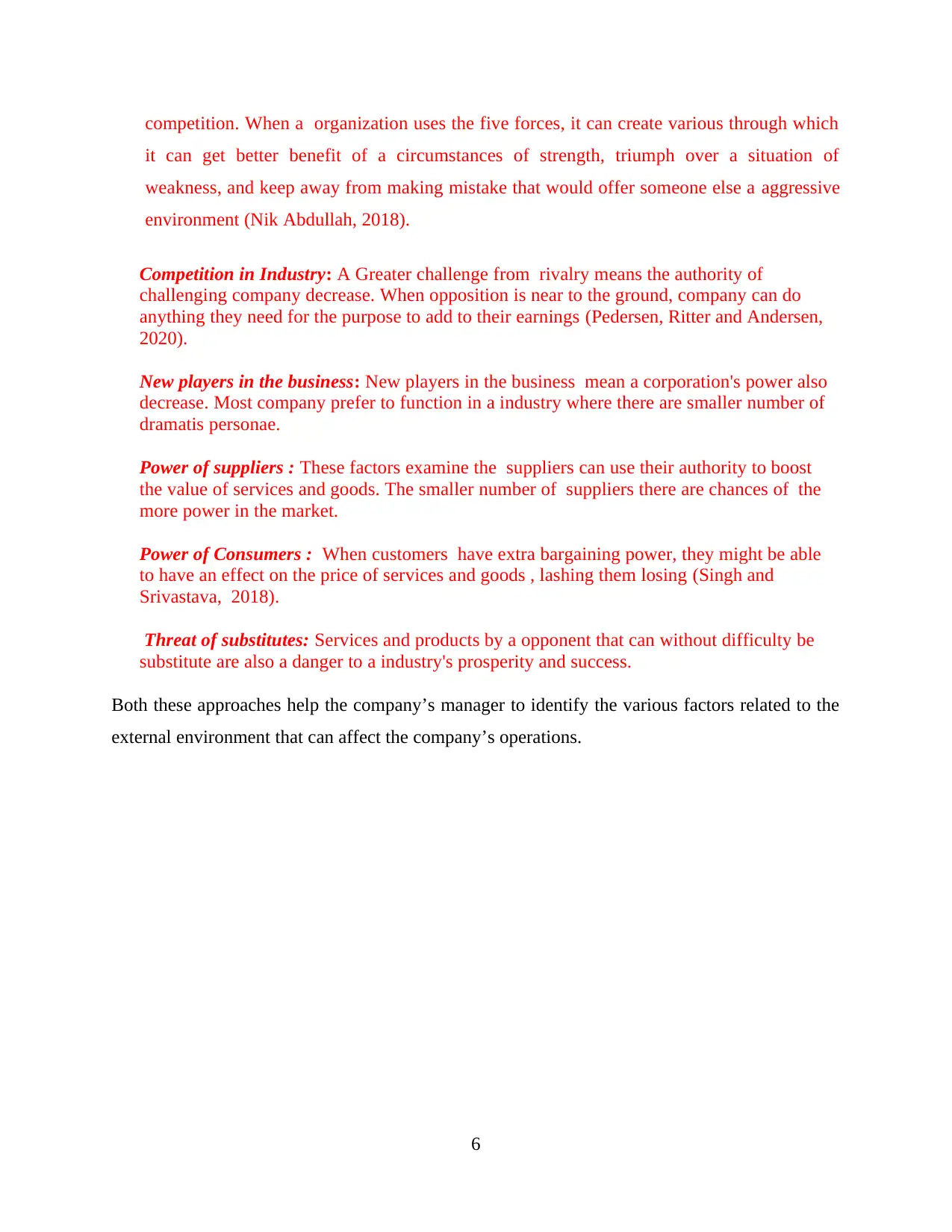
competition. When a organization uses the five forces, it can create various through which
it can get better benefit of a circumstances of strength, triumph over a situation of
weakness, and keep away from making mistake that would offer someone else a aggressive
environment (Nik Abdullah, 2018).
Competition in Industry: A Greater challenge from rivalry means the authority of
challenging company decrease. When opposition is near to the ground, company can do
anything they need for the purpose to add to their earnings (Pedersen, Ritter and Andersen,
2020).
New players in the business: New players in the business mean a corporation's power also
decrease. Most company prefer to function in a industry where there are smaller number of
dramatis personae.
Power of suppliers : These factors examine the suppliers can use their authority to boost
the value of services and goods. The smaller number of suppliers there are chances of the
more power in the market.
Power of Consumers : When customers have extra bargaining power, they might be able
to have an effect on the price of services and goods , lashing them losing (Singh and
Srivastava, 2018).
Threat of substitutes: Services and products by a opponent that can without difficulty be
substitute are also a danger to a industry's prosperity and success.
Both these approaches help the company’s manager to identify the various factors related to the
external environment that can affect the company’s operations.
6
it can get better benefit of a circumstances of strength, triumph over a situation of
weakness, and keep away from making mistake that would offer someone else a aggressive
environment (Nik Abdullah, 2018).
Competition in Industry: A Greater challenge from rivalry means the authority of
challenging company decrease. When opposition is near to the ground, company can do
anything they need for the purpose to add to their earnings (Pedersen, Ritter and Andersen,
2020).
New players in the business: New players in the business mean a corporation's power also
decrease. Most company prefer to function in a industry where there are smaller number of
dramatis personae.
Power of suppliers : These factors examine the suppliers can use their authority to boost
the value of services and goods. The smaller number of suppliers there are chances of the
more power in the market.
Power of Consumers : When customers have extra bargaining power, they might be able
to have an effect on the price of services and goods , lashing them losing (Singh and
Srivastava, 2018).
Threat of substitutes: Services and products by a opponent that can without difficulty be
substitute are also a danger to a industry's prosperity and success.
Both these approaches help the company’s manager to identify the various factors related to the
external environment that can affect the company’s operations.
6
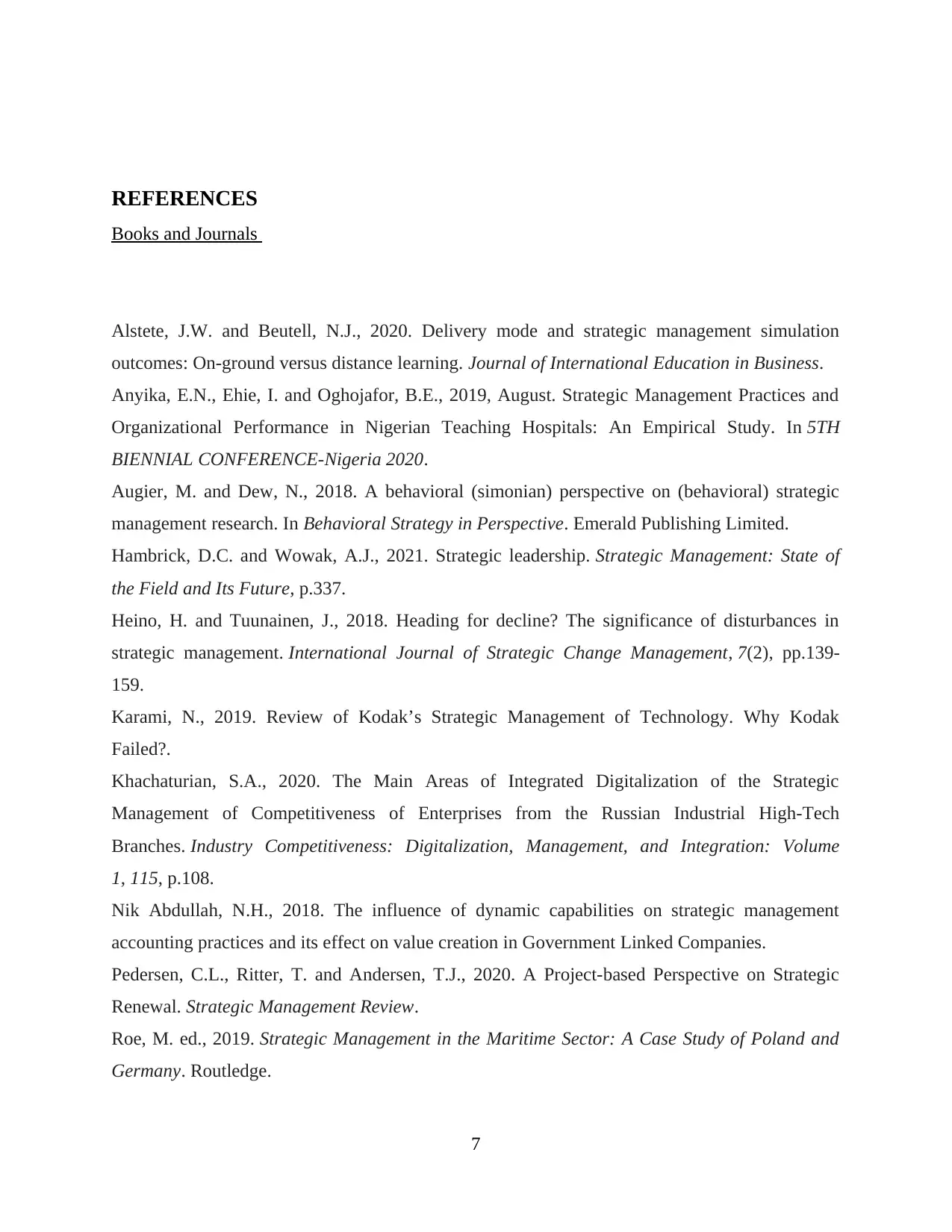
REFERENCES
Books and Journals
Alstete, J.W. and Beutell, N.J., 2020. Delivery mode and strategic management simulation
outcomes: On-ground versus distance learning. Journal of International Education in Business.
Anyika, E.N., Ehie, I. and Oghojafor, B.E., 2019, August. Strategic Management Practices and
Organizational Performance in Nigerian Teaching Hospitals: An Empirical Study. In 5TH
BIENNIAL CONFERENCE-Nigeria 2020.
Augier, M. and Dew, N., 2018. A behavioral (simonian) perspective on (behavioral) strategic
management research. In Behavioral Strategy in Perspective. Emerald Publishing Limited.
Hambrick, D.C. and Wowak, A.J., 2021. Strategic leadership. Strategic Management: State of
the Field and Its Future, p.337.
Heino, H. and Tuunainen, J., 2018. Heading for decline? The significance of disturbances in
strategic management. International Journal of Strategic Change Management, 7(2), pp.139-
159.
Karami, N., 2019. Review of Kodak’s Strategic Management of Technology. Why Kodak
Failed?.
Khachaturian, S.A., 2020. The Main Areas of Integrated Digitalization of the Strategic
Management of Competitiveness of Enterprises from the Russian Industrial High-Tech
Branches. Industry Competitiveness: Digitalization, Management, and Integration: Volume
1, 115, p.108.
Nik Abdullah, N.H., 2018. The influence of dynamic capabilities on strategic management
accounting practices and its effect on value creation in Government Linked Companies.
Pedersen, C.L., Ritter, T. and Andersen, T.J., 2020. A Project-based Perspective on Strategic
Renewal. Strategic Management Review.
Roe, M. ed., 2019. Strategic Management in the Maritime Sector: A Case Study of Poland and
Germany. Routledge.
7
Books and Journals
Alstete, J.W. and Beutell, N.J., 2020. Delivery mode and strategic management simulation
outcomes: On-ground versus distance learning. Journal of International Education in Business.
Anyika, E.N., Ehie, I. and Oghojafor, B.E., 2019, August. Strategic Management Practices and
Organizational Performance in Nigerian Teaching Hospitals: An Empirical Study. In 5TH
BIENNIAL CONFERENCE-Nigeria 2020.
Augier, M. and Dew, N., 2018. A behavioral (simonian) perspective on (behavioral) strategic
management research. In Behavioral Strategy in Perspective. Emerald Publishing Limited.
Hambrick, D.C. and Wowak, A.J., 2021. Strategic leadership. Strategic Management: State of
the Field and Its Future, p.337.
Heino, H. and Tuunainen, J., 2018. Heading for decline? The significance of disturbances in
strategic management. International Journal of Strategic Change Management, 7(2), pp.139-
159.
Karami, N., 2019. Review of Kodak’s Strategic Management of Technology. Why Kodak
Failed?.
Khachaturian, S.A., 2020. The Main Areas of Integrated Digitalization of the Strategic
Management of Competitiveness of Enterprises from the Russian Industrial High-Tech
Branches. Industry Competitiveness: Digitalization, Management, and Integration: Volume
1, 115, p.108.
Nik Abdullah, N.H., 2018. The influence of dynamic capabilities on strategic management
accounting practices and its effect on value creation in Government Linked Companies.
Pedersen, C.L., Ritter, T. and Andersen, T.J., 2020. A Project-based Perspective on Strategic
Renewal. Strategic Management Review.
Roe, M. ed., 2019. Strategic Management in the Maritime Sector: A Case Study of Poland and
Germany. Routledge.
7
⊘ This is a preview!⊘
Do you want full access?
Subscribe today to unlock all pages.

Trusted by 1+ million students worldwide
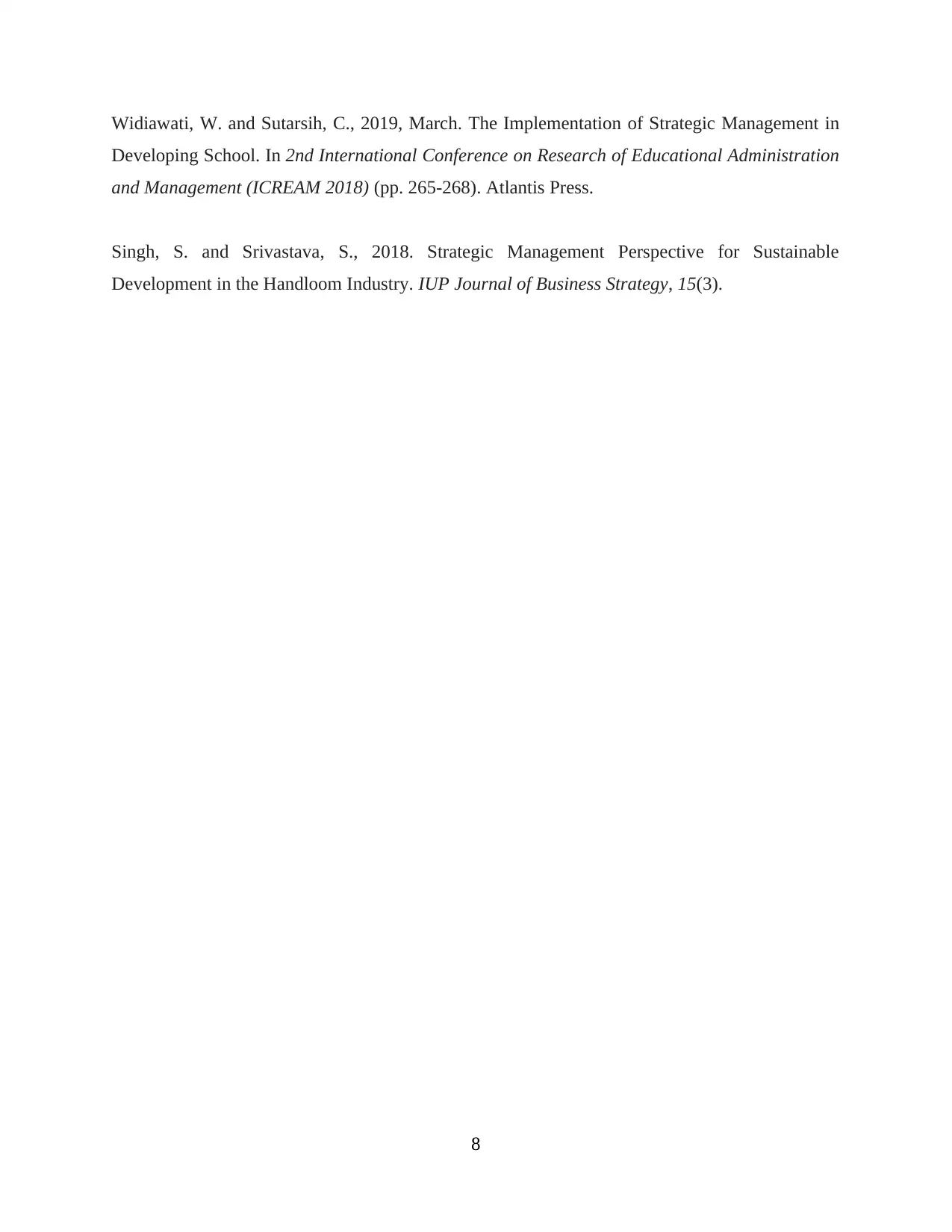
Widiawati, W. and Sutarsih, C., 2019, March. The Implementation of Strategic Management in
Developing School. In 2nd International Conference on Research of Educational Administration
and Management (ICREAM 2018) (pp. 265-268). Atlantis Press.
Singh, S. and Srivastava, S., 2018. Strategic Management Perspective for Sustainable
Development in the Handloom Industry. IUP Journal of Business Strategy, 15(3).
8
Developing School. In 2nd International Conference on Research of Educational Administration
and Management (ICREAM 2018) (pp. 265-268). Atlantis Press.
Singh, S. and Srivastava, S., 2018. Strategic Management Perspective for Sustainable
Development in the Handloom Industry. IUP Journal of Business Strategy, 15(3).
8
Paraphrase This Document
Need a fresh take? Get an instant paraphrase of this document with our AI Paraphraser

9
1 out of 11
Related Documents
Your All-in-One AI-Powered Toolkit for Academic Success.
+13062052269
info@desklib.com
Available 24*7 on WhatsApp / Email
![[object Object]](/_next/static/media/star-bottom.7253800d.svg)
Unlock your academic potential
Copyright © 2020–2025 A2Z Services. All Rights Reserved. Developed and managed by ZUCOL.




